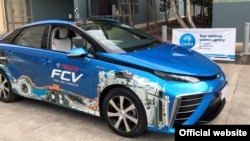Australian scientists have test driven two cars powered by a carbon-free fuel derived from ammonia. A team from the Australian government’s research agency, the CSIRO (Commonwealth Scientific and Industrial Research Organization), says the pioneering technology will allow highly flammable hydrogen to be safely transported in the form of ammonia and used as a widely available fuel.
Researchers have found a way to use a thin membrane to turn Australian-made hydrogen into ammonia. This could be shipped safely to markets in Asia, as well as parts of Europe. At its destination, the liquid ammonia would then be converted back into hydrogen, and used to power cars and buses, as well as for electricity generation and industrial processes.
David Harris, CSIRO research director says “the special thing about the technology that we have is that it allows you to produce very pure hydrogen directly with a membrane system from ammonia.”
The technology has the support of Japanese car maker Toyota and South Korea’s Hyundai Motor Company.
‘Watershed moment’
Scientists say hydrogen, a highly-flammable gas that can be volatile and hard to transport safely, creates a low emission fuel for cars. The Australian team describes the membrane technology that separates hydrogen from other gases as a “watershed moment for energy.”
Claire Johnson, the chief executive of Hydrogen Mobility Australia, an industry association, says the pioneering research could forever change the transport sector.
“We see that as a really exciting opportunity to decarbonize the transport sector, but also position Australia as one of the lead suppliers of hydrogen around the world. There is some competition to play that role, however. Norway, Brunei and Saudi Arabia have all flagged that they wish to be an exporter of hydrogen around the world.”
There are only a handful of hydrogen-powered cars in Australia, but there are tens of thousands across Japan, South Korea and Singapore. The South Korean government has recently announced plans for 16,000 more hydrogen-fueled cars and 310 special refilling stations.





